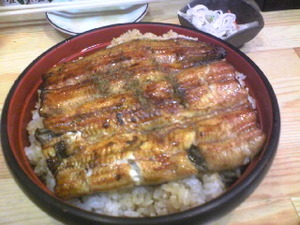
鰻の蒲焼の匂いを空腹中にかぐともう鰻以外のことを考えることが
できなくなってしまうのは自分だけではないと思いますが、今日の
自分はまさにそれでした(焼肉の匂いも同等にやっかいですが)
今日のランチは東五反田にて鰻丼を食べました
「よね山」は五反田界隈ではコアなファンが根付いている鰻料理の専門店で、
小さい店構えながらいつも「旨い鰻オーラ」を放出しています
職人気質のご主人が丁寧に焼いて出してくれるランチタイムの
鰻丼はなんと900円、しかもお吸い物とお新香も付き、さらには
その日のおかず(今日は蓮根と鶏肉に筑前煮)が付きこの値段という
儲け度外視のお店です
国産鰻を出すのが心情らしくご主人がその日の鰻の産地を丁寧に
教えてくれます(今日は筑波産の鰻)
Grilled unagi is a delicacy in Japan, popular not only for its flavor but also for its stamina-giving properties. It's traditionally eaten during one of the hottest days of the summer (sometime in late July) to provide strength and vitality for the rest of the year.
Good unagi combines a rich flavor (a bit like pate) with an appetizing texture, crisp on the outside but tender on the inside. The cooking process is what makes the eel both crisp and tender: The eels are first grilled over hot charcoals, then steamed to remove excess fat, then seasoned with a sweetish sauce and grilled a second time. In the Kansai area (around Osaka) the steaming step is omitted and the eel is grilled longer, burning off the excess fat and producing an even crisper skin.
The ingredients in the sweet basting sauce are important to the final taste of the unagi, and different restaurants have their own secret recipes. The quality of the charcoal used is also important: The best charcoal is made from hard oak wood, and the aromatic smoke adds a special flavor to the eel as it grills.
As for the eels themselves, the best are caught wild rather than bred in eel farms, with the ideal size between 30 and 50 centimeters (12-20 inches). Fancy unagi restaurants keep tanks full of live eels, and they don't begin preparing your eel until after you've ordered. This process takes a bit of time and patience, but you're guaranteed completely fresh eel, and many diners feel the results are well worth the wait.
Unagi restaurants can be recognized by an elongated Japanese "u" character (the first character in "unagi"), fashioned to resemble an eel and displayed prominently on the shop sign or curtain.
Unagi Dishes
Grilled unagi on skewers without rice is called kabayaki, and it's often served as an hors d'oeuvre with drinks. This same grilled unagi is also served over a bed of rice as a main course, called either unajuu or unagi donburi. Each variety comes in several different sizes.
Eel grilled without sauce is called shirayaki. This plain form of eel is popular with unagi purists. When you order a full-course eel meal you'll be served kimosui, a clear soup made from eel livers. The livers are very nutritious, although not everyone enjoys the taste.
Some unagi restaurants also serve dojO (called loach in English), a small fish related to the eel and caught in local waters in the summer. Some restaurants specialize in dojo, while others concentrate on unagi. The best known dojo dish is yanagawa-nabe, a mild casserole made with boiled dojo, burdock root and eggs.
At the table you may lightly sprinkle your unagi (or dojo) with sansho, a powdered aromatic Japanese pepper.